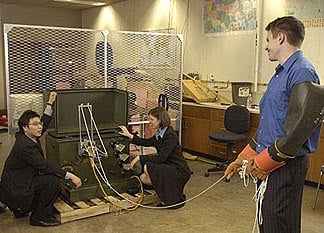 For electrical utility workers, detaching a transformer’s power connector can be dangerous business. The operation sometimes triggers an explosive arc, traveling as far as eight feet from the transformer, which can cause serious skin burns and eye injuries.
For electrical utility workers, detaching a transformer’s power connector can be dangerous business. The operation sometimes triggers an explosive arc, traveling as far as eight feet from the transformer, which can cause serious skin burns and eye injuries.
Now a team of mechanical engineering students has invented a new tool aimed at allowing utility workers to do their job at a safe distance. Their prototype was built last academic year at the request of Baltimore Gas & Electric Company (BGE). It consists of a lightweight aluminum frame that uses rope and a lever-and-pulley system to enable the worker to detach the transformer’s power connector (known as the load break elbow) from 10 to 12 feet away.
“We’re very pleased with the outcome of this project,” says Bruce R. Hirsch, a BGE representative who worked with the students. “What they’ve given us is a good start. It’s a very simple design, and they’ve suggested some further refinements.”
The student team initially considered complex designs that would employ hydraulic or pneumatic power. “We finally decided on an all mechanical design that would require no batteries or motors,” explains Kyle Azevedo ’08, who worked with classmates Julie Blumreiter ’08 and Doo Hyun Lee ’08. “One of our primary goals for this tool was simplicity.”
The finished prototype features three guide rails that surround the transformer’s elbow connection. A sliding component of the device houses a clamp that grabs onto the connector. The utility technician can then use the lever and pulley system to detach the power line from a safe distance. Compared to the current “hot stick” procedure, their device requires the worker to exert only a third as much force, the students say. The tool also should be simple to transport and utilize during repair assignments, commonly made in suburban neighborhoods. “We wanted to make this device as small and as light as possible so that one worker could easily operate it alone,” says Lee.
The utility worker’s device was one of nine projects completed last year by undergraduates in the two-semester Engineering Design Project course, taught by Mike Johnson and other faculty members in the Department of Mechanical Engineering. The team used about $9,600 to make the prototype but estimated that it could be mass-produced for far less. They’ve now turned the prototype over to BGE, which will conduct further tests and consider refinements in the device before deciding whether to deploy it in the field.




